Science Highlights, September 16, 2015
Awards and Recognition
Materials Physics and Applications
Hybrid ultrasmall gold nanocluster developed for enzymatic fuel cells
Materials Science and Technology
LANL makes depleted uranium targets for NNSA Global Threat Reduction Initiative
Awards and Recognition
Dee Magnoni elected to presidential succession of the Special Libraries Association

Dee Magnoni
The Special Libraries Association (SLA) has elected Dee Magnoni, Research Library director (SRO-RL) at the Los Alamos National Laboratory, to serve as president of the association in 2017. Magnoni and three other information professionals will begin serving three-year terms on the SLA Board of Directors in January 2016. She will serve one year as president-elect, followed by a year as president and a year as past president.
Passionate about mentoring and development, dedicated to creating partnerships to effect change, and skilled in leveraging technology to provide tools and solutions to customers and colleagues, Magnoni is well equipped to lead the Special Libraries Association as it implements programmatic and structural changes to position itself for the future. She brings more than 20 years’ experience in corporate, academic and government settings to her new role in SLA, where she has served in a variety of capacities. Magnoni was president of the Rhode Island and the Boston (now New England) chapters, and has chaired the Information Technology, Engineering, and the Leadership & Management divisions. She served on the SLA Board of Directors, chaired the 2014 Annual Conference Advisory Council, and currently chairs the Volunteer Experience Task Force.
Magnoni has a master’s degree in library science from the State University of New York – Albany. She served as the first library director at Olin College of Engineering in Needham, MA. Magnoni developed many of their library services to integrate library services into institutional practices and make library resources accessible to users. She joined the Laboratory in January 2014 as the Research Library director. Magnoni leads 35 staff and oversees the Lab’s work in applied information science research, the development of digital library applications, and a wide range of services and resources.
In recognition of her service to SLA and the library profession, Magnoni has been named a Fellow of the SLA and has received the Rose Vormelker Award. The New England Chapter honored her with its Special Recognition Award for her years of chapter service and contributions to the association. Outside of SLA, Mangnoni serves as vice chair of the American Society for Testing and Materials’ Committee on Publications. She has also been a member of McGraw Hill’s Library Advisory Board and the Institute of Electrical and Electronics Engineers’ Library Advisory Council.
The Special Libraries Association is a nonprofit global organization for innovative information professionals and their strategic partners, serving more than 7,000 members in 75 countries in the information profession, including corporate, academic and government information specialists, through learning, advocacy, and networking initiatives. Technical contact: Dee Magnoni
Chemistry
Highly efficient solar concentrators developed using nontoxic quantum dots
Researchers in the Laboratory’s Center for Advanced Solar Photophysics (CASP) and collaborators at the University of Milan-Bicocca have developed advances in semiconductor quantum dot technology that could allow windows to function as luminescent solar concentrators to harvest energy from sunlight. Nature Nanotechnology published the research.
Luminescent solar concentrators serving as semitransparent photovoltaic windows could become an important element in net zero energy consumption buildings of the future. Concentrators typically consist of a waveguide coated or doped with highly emissive chromophores (materials that absorb light). The chromophores absorb direct and diffused sunlight and re-emit it at a longer wavelength. Luminescence propagates to the waveguide edges by total internal reflection. Photovoltaic cells installed along the slab perimeter convert the luminescence into electricity. The surface area of the slab exposed to sunlight is much larger than the area of its edges. Therefore, the luminescent solar concentrator effectively increases the photon density incident onto the photovoltaic cell, which boosts its photocurrent.
Colloidal quantum dots, a type of nanosized particles, are promising chromophores for luminescent solar concentrators because they can be engineered to provide the large Stokes shift necessary for suppressing light reabsorption losses in large-area devices. (Stokes shift is the difference between positions of the band maxima of the absorption and emission spectra of the same electronic transition). Existing Stokes-shift-engineered quantum dots have shortcomings for real-world applications because: 1) they are based on toxic cadmium, 2) absorb only a small portion of the solar light, and 3) have a strong yellow/red coloring.

Figure 1. Photographs of a colorful scene (left): without using any filters and (right) with the newly developed luminescent solar concentrator placed in front of the camera lens.
CASP researchers have developed the first large-area quantum dot–luminescent solar concentrators free of toxic elements, with reduced reabsorption and extended coverage of the solar spectrum. The new devices use quantum dots of a complex, nontoxic composition that includes copper (Cu), indium (In), selenium (Se) and sulfur (S). Incorporating CuInSexS2–x quantum dots into a photo-polymerized matrix produces freestanding, colorless slabs that introduce no distortion to perceived colors (Figure 2). The near-infrared emission is invisible to a human eye and is suitable for most common solar cells based on silicon. The suppressed reabsorption and high emission efficiencies of the quantum dots enables an optical power efficiency of 3.2%. Thus, the material has promising properties for photovoltaic windows.
A key element of this work is a procedure comparable to the cell casting industrial method used for fabricating high optical quality polymer windows. It involves a University of Milan-Bicocca new protocol to encapsulate quantum dots into a high optical quality transparent polymer matrix. The polymer used in this study is a cross-linked poly(lauryl methacrylate), which belongs to the family of acrylate polymers. Its long side-chains prevent agglomeration of the quantum dots and provide them with a local environment that is similar to that of the original colloidal suspension. This preserves the light emission properties of the quantum dots upon encapsulation into the polymer.
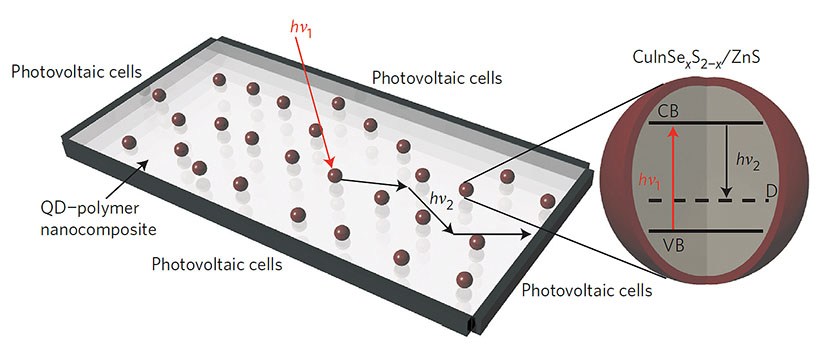
Figure 2. Schematic of a neutral-density luminescent solar concentrator composed of a polymer matrix incorporating ZnS-coated CISeS quantum dots (QDs). (Right inset): A simplified structure of the band-edge electronic states in CISeS quantum dots (QD) responsible for light emission and absorption. Light absorption is dominated by optical transitions involving intrinsic quantized states (the valence and conduction bands are indicated as VB and CB respectively, the band-edge transition is shown by a red arrow). Emission (black arrow) involves a band-edge electron and an intragap hole state associated with a native defect (D), which results in a large Stokes shift. (Bottom left): Illuminated luminescent solar collector viewed with an infrared camera.
Reference: “Highly Efficient Large-area Colourless Luminescent Solar Concentrators using Heavy-metal-free Colloidal Quantum Dots,” Nature Nanotechnology, published online 24 August 2015; doi: 10.1038/nnano.2015.178. Authors: Francesco Meinardi, Francesco Carulli, Annalisa Colombo, Roberto Simonutti, and Sergio Brovelli (University of Milan-Bicocca); Hunter McDaniel (formerly CASP and currently UbiQD); Kirill A. Velizhanin (Physics and Chemistry of Materials, T-1 and CASP); Nikolay S. Makarov and Victor I. Klimov (CASP). Klimov led the CASP research, and Sergio Brovelli and Francesco Meinardi coordinated the University of Milan-Bicocca team in Italy.
The Center for Advanced Solar Photophysics, a DOE Office of Science Energy Frontiers Research Center, funded the Los Alamos work. The research supports the Laboratory’s Energy Security mission area and the Materials for the Future science pillar though the development of materials for solar harvesting and electricity generation. Technical contact: Victor KlimovEducational Outreach
Researchers provide expertise for Bradbury Science Museum exhibit
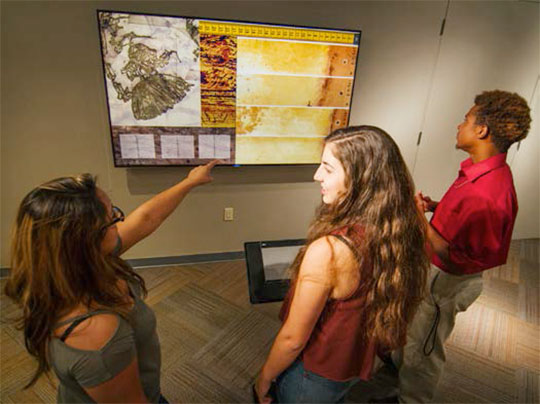
Photo. Museum visitors get a sneak peek at the Climate Prisms exhibit. A layout shows ice cores (right) and notes (bottom) complemented with an abstract construction by artist Francesca Samsel (left).
Los Alamos employees served key roles in the development of the new exhibit Climate Prisms: Arctic, which will open soon at the Bradbury Science Museum as part of the Environmental Stewardship and Monitoring exhibit. The interactive exhibit creates an artistic, quiet walk through what science researchers learn and experience in the Arctic. Climate Prisms: Arctic uses art, poetry, images, videos, and scientific presentations, all of which allow users to “self-construct” their learning and understanding of climate change.
Scientific lead Cathy Wilson (Earth System Observations, EES-14) and artistic lead Francesca Samsel (Applied Computer Science, CCS-7 and the Center for Agile Technology at the University of Texas – Austin) provided expertise for the development of the exhibit. Other contributors included: Mark Petersen (Computational Physics and Methods, CCS-2), Garrett Altmann and Heather Throckmorton (EES-14), Bruce Campbell (Rhode Island School of Design), Linda Deck (Bradbury Science Museum, CPA-BSM), Mireya Rodriguez (Site Infrastructure and Programs Software, SAE-3), David Estrada (professional photographer and videographer), and Dominic Brooks (DOE Science Undergraduate Laboratory Intern from the University of Texas – Austin)
Wilson is the co-Principal Investigator of the DOE Office of Biological and Environmental Research’s Next Generation Ecosystem Experiment (NGEE) – Arctic. She leads investigations of climate change in the Arctic. Samsel is a visual artist working with the Applied Computer Science Team to help the Climate Prisms team express scientific data in a way that enables deeper engagement. Samsel’s work in scientific visualization combined with Wilson’s climate change data created the novel learning experience that is Climate Prisms.
The exhibit can be viewed at the Bradbury Science Museum. More information: http://www.lanl.gov/museum/exhibitions/tech-lab/climate-prisms-exhibit.php
Technical contact: Cathy Wilson
Scientists teach short course on fuel cells
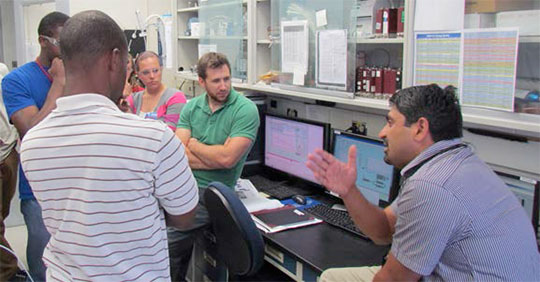
Photo. Materials Synthesis and Integrated Devices (MPA-11) scientists, Rangachary Mukundan (seated) and Tommy Rockward (left), during a demonstration in their fuel cell laboratory.
In support of the DOE’s Technology-to-Market activities in the Office of Energy Efficiency and Renewable Energy (EERE), Los Alamos researchers used their extensive knowledge and state-of-the-art capabilities to host a three-day hands-on short course on fuel cells. The DOE’s Fuel Cell Technology Office Technology-to-Market activities efforts place emphasis on national laboratories increasing their industrial contacts, engaging more companies, and developing technology skills.
Participants gained valuable insight by interacting and working alongside the LANL fuel cell team during the workshop. Fourteen participants from industry, universities, and colleges attended, including Giner, Inc., Pajarito Powders, LLC, University of Delaware, Pittsburg State University, University of New Mexico, New Mexico State University, Southern University, Tuskegee University, and Benedict College.
Los Alamos scientists gave presentations covering Hydrogen and Lab Safety, the Laboratory’s Membrane-and-Electrode Process, Fuel Cell Materials Characterization, Modeling, Durability and Testing. In addition, laboratory demonstrations such as analysis of fuel cell performance, cyclic voltammetry, and impedance spectroscopy actively involved the participants.
The Laboratory remains at the forefront of Fuel Cell Research and Development, and their leadership and commitment have been instrumental in supporting DOE R&D efforts. The DOE funded this effort under Office of Energy Efficiency and Renewable Energy’s Technology-to-Market activities initiative. The work supports the Laboratory’s Energy Security mission area and the Materials for the Future science pillar through development of fuel cells for clean transportation. Technical contacts: Andrew Dattelbaum and Rod Borup
High Performance Computing
Trinity-Haswell High Performance Computing System delivered to LANL
Trinity is the latest major high performance computer acquisition funded by the NNSA’s Advanced Simulation and Computing (ASC) Program. Cray, Inc. will build, deliver and install Trinity. The computing system will be delivered in two phases. The first phase, delivered in July 2015, is based on the Intel Haswell processors. The second phase, the Intel Knight’s Landing (KNL) processors, will be delivered in the third quarter of Fiscal Year 2016. A joint LANL and Sandia National Laboratories partnership as part of the New Mexico Alliance for Computing at Extreme Scale (ACES) procured the Trinity system. The early phase of the acquisition also included a joint effort with National Energy Research Scientific Computing (NERSC). Trinity is named after the first nuclear weapons test conducted in New Mexico 70 years ago.
Trinity will enable the largest, most demanding Directed Stockpile Work applications that support the Stockpile Stewardship Program. Like all NNSA Advanced Technology systems, it will be used by applications from all three NNSA laboratories (Los Alamos, Sandia, and Livermore). The mission need was developed with tri-laboratory input and concentrates on increases in geometric and physics fidelities in 3-D while satisfying analysts’ time-to-solution expectations. Trinity was designed with memory as the major requirement rather than by floating point operations per second (FLOPS). The main driver was the desire to run multiple jobs each using about 750 TB of memory.
Staff from Cray, Los Alamos, and Sandia will deploy Trinity. The platform consists of the compute nodes, the Aries interconnect, the Lustre parallel file system, burst buffers, two application regression test systems, one system development testbed, and on-site system and application analysts, as well as maintenance for the lifetime of the system. Non-recurring engineering areas that are part of the contract include: 1) burst buffer capability, 2) advanced power management, and 3) the Trinity Center of Excellence. The Center of Excellence is an essential element in making effective use of Trinity because it directly supports modifying select applications for Trinity.

Photo. Trinity high performance computer.
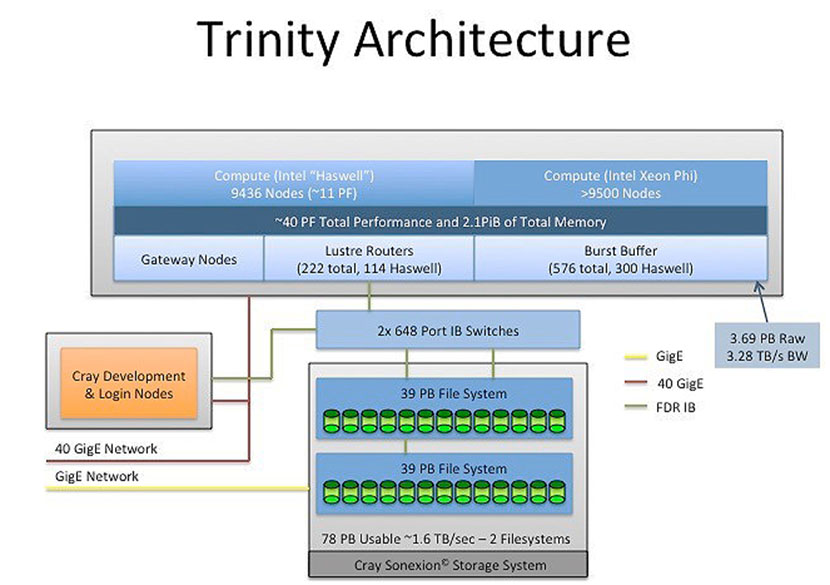
Figure 3. Architecture for Trinity.
Trinity introduces several significant new architectural features. The KNL are self-hosted many-core processors, not accelerators. There are 60+ cores on each chip, a sixfold increase over current multi-core Xeon chips. Although each KNL core has lower performance than a Xeon core, a greater than tenfold increase in thread parallelism will recover performance. The KNL also doubles the width of vector instructions with the dual AVX-512 SIMD units.
The many-core architecture with hierarchal memory and burst buffers poses significant challenges to an application’s ability to use the KNL partition effectively. The payoff is significantly more performance at the same power cost as the Haswell partition. The Trinity Center of Excellence has been established to ensure that the KNL partition is effectively used upon initial deployment. The Center of Excellence will provide support from both Cray and Intel to work with select applications from each laboratory to facilitate the code transition to Trinity.
Staff have made significant progress for Trinity. The cabinets have been installed and are using the warm-water cooling infrastructure installed at LANL’s Nicholas Metropolis Center. Two application testbed systems and one system development testbed have been delivered. Trinitite (installed at Los Alamos) and Mutrino (installed at Sandia) are application testbeds to get applications ready to run on Trinity. Each system initially consists of 100 nodes (3200 Haswell cores) and will be upgraded with an additional 100 KNL nodes next year. Gadget is a 20-node (640 Haswell cores) system installed at Los Alamos that will be used for system and software development. It will also be upgraded with another 20 KNL nodes in 2016. Users from the Trinity Center of Excellence are focusing on the application transition of three codes (one from each of the labs) to the new KNL architecture. The researchers are using Trinitite to develop and test codes for running on Trinity. Trinitite resides in an internal Laboratory network and is accessible for remote users from Lawrence Livermore and Sandia National Laboratories. Researchers have held discovery sessions with Intel and Cray to examine what will be required to move codes to the new architecture. By October, these applications will have access to an early version of a KNL single node system.
The completion of system integration and acceptance testing is the next step in getting Trinity-Haswell ready for use. After the acceptance testing is completed, the system will be used for Open Science applications from the three labs as part of system stabilization efforts during January and February 2016 in the unclassified LANL network. Then Trinity will be connected to the classified network for security accreditation. The Trinity-Haswell system will run the regular classified production workload starting in June 2016. Cielo, the current large ASC capability platform in use by the tri-labs, is scheduled for decommissioning at the end of June 2016. Shortly thereafter, the KNL partition will be installed. The entire system will be in production in early Fiscal Year 17.
High Performance Computing (HPC) Division employees are involved in the deployment efforts. Technical staff from Computer, Computational, and Statistical Sciences (CCS), X-Computational Physics (XCP) and X-Theoretical Design (XTD) divisions are engaged with other aspects of the project, including the Trinity Center of Excellence efforts. The NNSA Advanced Simulation and Computing Program funds Trinity, which supports the Laboratory’s Nuclear Deterrence mission area and the Information, Science, and Technology science pillar through the capability to perform complex, high fidelity simulations. More information about Trinity: http://www.lanl.gov/projects/trinity/. Technical contacts: Manuel Vigil and Bill Archer
Materials Physics and Applications
Hybrid ultrasmall gold nanocluster developed for enzymatic fuel cells
With fossil fuel sources dwindling, alternate environmentally “green” sources of energy using natural resources such as air, water, and sunlight are needed. Enzymatic fuel cells and nanomaterials show great promise in this regard because they can operate under environmentally benign neutral pH conditions. In research published in the Journal of the American Chemical Society, Los Alamos researchers and external collaborators have overcome a technical barrier to the development of efficient enzymatic fuels cell.
In enzymatic fuel cells, fuel is oxidized on the anode, while oxygen reduction reactions take place on the cathode, often using multi-copper oxidase enzymes such as bilirubin oxidase. Enzymatic fuel cell performance depends critically on how effectively the enzyme active sites can accept and donate electrons from the electrode by direct electron transfer. A major barrier to the development of enzymatic fuel cells is the lack of effective electron transfer between the enzyme active sites, which are usually buried approximately 10 Å from their surface, and the electrode. Therefore, effective mediators of electron transfer are needed.
The discrete electron state distributions of metal nanoclusters (less than 1.5 nm diameter and approximately 2-144 atoms of gold, silver, platinum, or copper) confer many unique properties for potential applications. Ligands (molecules that bind to a central metal atom) are necessary to form stable nanoclusters. For this study, the researchers chose single-stranded DNA as the ligand. DNA is a natural nanoscale material with high affinity for metal cations, and it can be used to assemble the cluster to other nanoscale material (e.g. carbon nanotubes).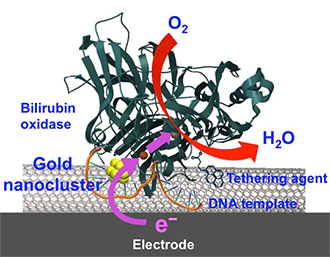
Figure 4. Schematic shows the integration of the AuNC with bilirubin oxidase and carbon nanotubes deposited as composite materials on electrode surface. The red arrow shows the conversion of molecular oxygen to water. The
The team developed a new DNA-templated gold nanocluster (AuNc) to enhance electron transfer. The researchers hypothesized that the ultra-small size (the clusters are approximately 7 atoms, approximately 0.9 nm in diameter) and unique electrochemical properties of DNA-templated gold nanoclusters could facilitate electron transfer to an oxygen reduction reaction at the enzyme active site and lower the overpotential (“extra” amount of energy required to drive an electrochemical reaction) of oxygen reduction reactions. Because proteins are electronically insulating, the researchers used conductive single-walled carbon nanotubes to help the bilirubin oxidase stick to the electrode as well as facilitate electron transfer. When AuNC is self-assembled with bilirubin oxidase and the carbon nanotubes, it acts as an enhancer of electron transfer and lowers the overpotential of oxygen reduction reactions by approximately 15 mV (as opposed to approximately 1-2 mV observed using other types of mediators) compared with the enzyme alone. AuNC also significantly enhances electrocatalytic current densities.
This novel role of the AuNC as enhancer of electron transfer at the enzyme-electrode interface makes it a potential candidate for the development of cathodes in enzymatic fuel cells because it boosts electron transfer without perturbing the mechanism of enzymatic O2 reduction. The team observed a clean four-electron reduction of oxygen (O2) with minimal production of the undesirable two-electron reduction product, hydrogen peroxide (H2O2). This unique application of AuNC as facilitator of electron transfer by improving thermodynamics and the kinetics of O2 reduction is unprecedented.
Reference: “A Hybrid DNA-Templated Gold Nanocluster For Enhanced Enzymatic Reduction of Oxygen,” Journal of the American Chemical Society; doi: 10.1021/jacs.5b05338. Authors: Saumen Chakraborty, Reginaldo C. Rocha, Anil Desireddy, Amy E. Boncella, and Jennifer S. Martinez (Center for Integrated Nanotechnologies, MPA-CINT); Sofia Babanova, Kateryna Artyushkova, and Plamen Atanassov (The University of New Mexico).
The study was enabled by a user proposal funded at the Center for Integrated Nanotechnologies (CINT), a DOE Office of Science User Facility, to The University of New Mexico Team in addition to their Air Force Office of Scientific Research and Air Force Office – Multi-University Research Initiative grant. The DOE Basic Energy Sciences, Biomolecular Materials Program and a Los Alamos Laboratory Directed Research and Development (LDRD) Postdoctoral Fellowship funded different aspects of the LANL researchers’ work.
This work supports the Laboratory’s Energy Security mission area and the Materials for the Future Science Pillar through the development of materials with emergent phenomena for environmentally “green” energy generation. Technical contacts: Saumen Chakraborty and Jennifer S. Martinez
Materials Science and Technology
LANL makes depleted uranium targets for NNSA Global Threat Reduction Initiative
Technetium-99m (Tc-99m) is the most commonly used medical isotope. It accounts for more than 80,000 medical imaging procedures every day to diagnose heart disease, cancer, and other conditions. Tc-99m is derived from the parent isotope molybdenum-99 (Mo-99), predominantly produced from the fission of uranium-235 in highly enriched uranium, a weapons grade material, in aging foreign reactors. In 2012, Congress passed the American Medical Isotopes Production Act to support domestic projects that could produce Mo-99 with low enriched uranium (which is not useful for weapons) instead. The Laboratory provides scientific expertise to develop the technology needed achieve this goal.
For one such project, called mini-SHINE, LANL researchers fabricated 21 clad depleted uranium targets at the Metallurgy Group’s (MST-6) Sigma Complex. Los Alamos was chosen for the work given its expertise in uranium processing and capabilities in making parts for experiments. Sigma offers casting, machining, welding, cleaning, and bonding of uranium materials, as well as characterization of uranium structures.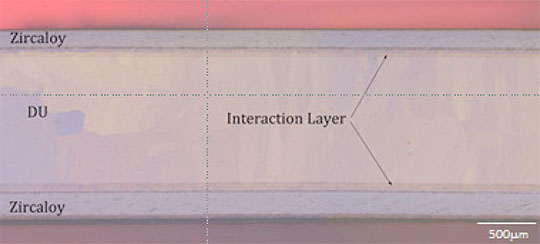
Figure 5. Microscopy image of thin development depleted uranium (DU) disk shows the interaction layer between depleted uranium and zircaloy. The white bar indicates the 500 micron scale.
The disks consist of a depleted uranium core cladded with zircaloy to yield a mechanically sound and high quality bond between the uranium core and the zircaloy cladding. The team optimized cleaning of components to ensure bonding of the depleted uranium /zircaloy interface. The researchers made a single circumferential electro-beam weld on the outer edge of each disk. The can components have a step joint to facilitate assembly and to provide proper alignment for electro-beam welding. Hot isostatic pressing of the depleted uranium disks created a strong bond at the depleted uranium /zircaloy interface to aid in heat transfer. The team made two depleted uranium disk assemblies for the developmental phase to analyze the depleted uranium /zircaloy bond. The work resulted in disks with quality bonding and precise final dimensions.
The final mini-SHINE assemblies are 2.1 inch-diameter disks of two thicknesses to accommodate the process assembly. The team assembled the depleted uranium disks as a core depleted uranium disk inserted into two machined zircaloy can plates. The investigators electro-discharge machined the depleted uranium core and the zircaloy cans according to Argonne National Laboratory’s specifications, including dimensional, flatness and out-of-round tolerances less than 0.01 inches. Ultrasonic testing inspection results show bonded areas and less bonded areas on all 21 depleted uranium disks. At least 99.5% of depleted uranium /zircaloy interfaces were bonded for the thin assemblies, and at least 95% of the interfaces were bonded for the thick assemblies.
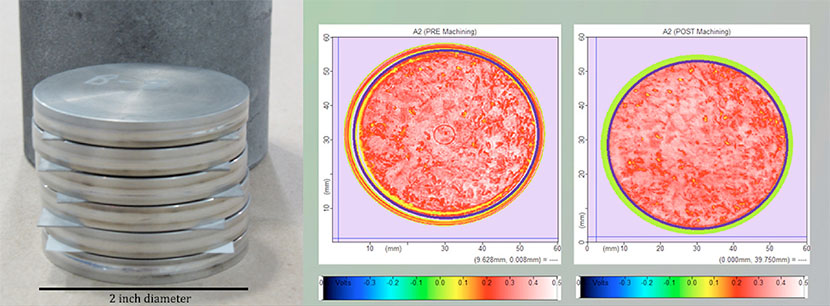
Figure 6. Disks after hot isostatic pressing and typical ultrasonic testing results showing bonded (red) and less bonded (yellow) areas.
Argonne National Laboratory compared the results of each depleted uranium disk to a thermal stress analysis report evaluating the effect of non-bonds on target life. All 21 disk assemblies met requirements for use in Argonne’s mini-SHINE demonstration to produce and purify Mo-99 from low enriched uranium. The demonstration is a joint effort with SHINE Medical Technologies. The SHINE approach, which is being developed by Morgridge Institute for Research, creates Mo-99 using a sub-critical aqueous solution of low enriched uranium at the Argonne Low Energy Accelerator Facility, where the fission reaction takes place. The mini-SHINE experiments with depleted uranium targets will investigate the solution chemistry and the retrieval of Mo-99.
Target fabricators included: David Alexander, Maria Peña, Matthew Dvornak, Donald Bucholz, Dave Dombrowski, Beverly Aikin, Bo Folks, Joel Montalvo, Victor Vargas, Michael Mauro, and Pallas Papin (MST-6); and Debra Summa (Non-Destructive Testing and Evaluation, AET-6).
The NNSA Office of Material Management and Minimization, Office of Conversion funded the work to help isotope producers convert to low enriched uranium targets and encourage the establishment of Mo-99 production in the United States. Deborah Dale (Nuclear Engineering and Nonproliferation, NEN-DO) is the program manager for the LANL effort. This research supports the Lab’s Global Security and Energy Security mission areas and the Materials for the Future science pillar through the development of a method to produce a medically important isotope while avoiding the use of highly enriched uranium. Technical contact: Maria PeñaPhysics
Inaugural issue of Journal of Dynamic Behavior of Materials published
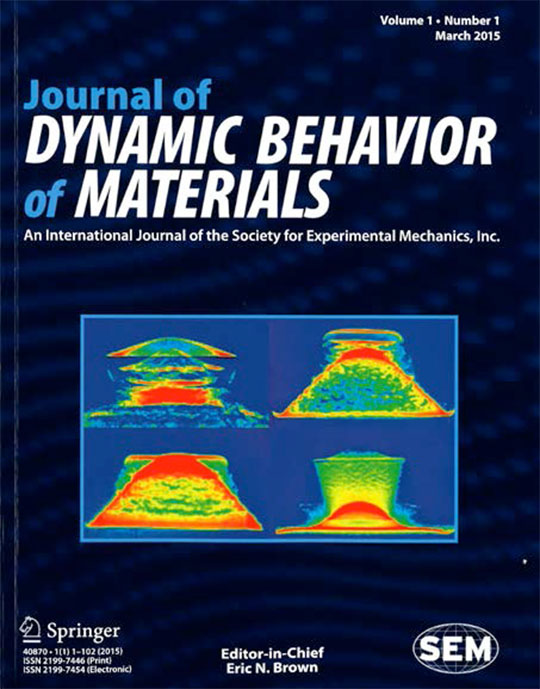
Figure 7. The journal’s cover image depicts a series of proton radiographs of disks (left to right, top to bottom) of aluminum, copper, tantalum, and tin that have been explosively shocked from below. The radiographs reveal the internal structure of the materials in these extreme conditions. For example, the aluminum sample shows the formation of layers of spall, and the tin sample displays characteristics of melting. Image courtesy of David Holtkamp (Neutron Science and Technology, P-23) and the Proton Radiography Team at Los Alamos National Laboratory.
The Society for Experimental Mechanics (SEM) and Springer have published the first issue of the Journal of Dynamic Behavior of Materials. Current and retired Laboratory researchers have major roles in the journal. Eric N. Brown (previously Neutron Science and Technology, P-23, now Explosive Science and Shock Physics, M-DO) is Editor-in-Chief, Ellen Cerreta (Materials Science in Radiation and Dynamics Extremes, MST-8) and Robert S. Hixson (retired from Weapons Experiments, WX Division, now with NSTec LLC) serve as associate technical editors, and Dana Dattelbaum (previously Shock and Detonation Physics, M-9, now Campaign 2 Program Manager) serves on the international advisory board. Brown has worked closely with SEM and its board of directors and staff over the past two years to launch the new journal.
The peer reviewed archival journal focuses on the response of materials to dynamic loading, particularly involving extreme conditions including high strain-rate, impact, blast, penetration, and shock response. Over the past decade there has been a dramatic increase in research on the science and engineering of the dynamic behavior of materials. The journal was created to provide the community a scientific outlet focused on both the materials science and engineering and dynamic loading aspects of their work. Experimental, theoretical, modeling and simulations, and interdisciplinary papers appear in the journal. The content also includes articles regarding the development of new methods, diagnostics, and techniques to study the dynamic response of materials. Link to the journal: http://www.springer.com/materials/special+types/journal/40870
The cover of the first issue of the Journal of Dynamic Behavior of Materials features a series of proton radiographs of disks taken at the Los Alamos Neutron Science Center (LANSCE) Proton Radiography Facility. The images reveal the internal structure of explosively shocked aluminum, copper, tantalum, and tin. The Laboratory is an international center of excellence for research in the field of dynamic behavior of materials and materials in extremes.
Articles can be submitted at www.editorialmanager.com/jdbm/. The Journal of Dynamic Behavior of Materials web page: http://www.springer.com/materials/special+types/journal/40870 Technical contacts: Eric Brown and Ellen Cerreta
Theoretical
Emil Mottola presents gravastar concept at the Hawking Radiation Conference
Laboratory researcher Emil Mottola (Nuclear and Particle Physics, Astrophysics and Cosmology, T-2) joined a veritable “who’s who” of the physics world in Stockholm, Sweden to participate in a weeklong conference to discuss the paradoxes of black holes. Topics included the origin of Hawking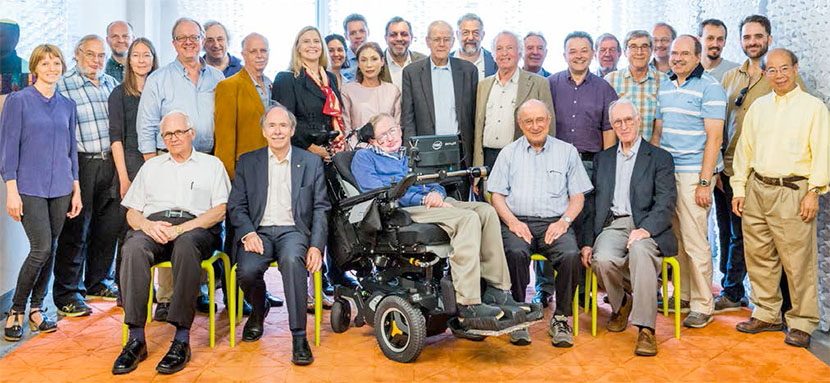
Photo. Group photo of the participants. Stephen Hawking is at the center of the front row.


Figure 8. (Left): Schematic comparing the structures from a classical black hole and the proposal for a gravastar. Credit: Samuel Velasco. (Right): The defocusing of null rays passing through the interior of a gravitational condensate star.
Reference: “Surface Tension and Negative Pressure Interior of a Non-Singular ‘Black Hole,’” Classical and Quantum Gravity (in press, 2015); arXiv: 1501.03806. Authors: Pawel O. Maxur and Emil Mottola.
After the conference, an online Reddit session organized by Tony Lund, the writer and director of the “Through the Wormhole: With Morgan Freeman” series on the Science channel, answered questions from the public. Mottola participated in the session and answered in greater detail on why he thinks black holes may not be holes at all. The Reddit page (https://www.reddit.com/r/IAmA/comments/3iuf6c/we_are_the_international_group_of_theoretical/) received over a million views.
X-Computational Physics
Young, Jupiter-like planet discovered
A team of researchers has discovered a Jupiter-like planet within a young system that could provide insights into planet formation and the development of gas giants in our solar system. Sciencexpress published the findings.
The planet, called 51 Eridani b, is the first exoplanet discovered by the Gemini Planet Imager, a new instrument operated by an international collaboration. The exoplanet is approximately 97 light-years from Earth and orbits the young (approximately 20 Myr-old) star 51 Eridani, a faint star visible with the naked eye in the winter constellation Eridanus. The exoplanet is 13 astronomical units from the star (a distance that is approximately 13 times the distance from the Sun to the Earth). This distance is equivalent to being between Saturn and Uranus in our solar system. 51 Eridani b is a million times fainter than its star. Near-infrared observations reveal the strongest methane signature ever detected on an alien planet, which should yield information regarding how the planet formed.
Figure 9. Artistic conception of the Jupiter-like exoplanet 51 Eridani b, with the hot layers deep in its atmosphere glowing through the clouds. Because of its young age, it is still hot and carries information regarding the way it was formed 20 million years ago. Credit: Danielle Futselaar and Franck Marchi (SETI Institute)
One of the best ways to learn how our solar system evolved is to investigate younger star systems in the early stages of development. Researchers designed the Gemini Planet Imager specifically to discover and analyze faint, young planets orbiting young, bright stars. The imager is located on the 8-meter Gemini South Telescope in Chile, and the coordinating science teams are spread globally.
The Gemini Planet Imager has several advantages compared with other planet-seeking instruments. While NASA’s Kepler space observatory has discovered thousands of planets, it does so indirectly by detecting a loss of starlight as a planet passes in front of its star. Instead, the Gemini Planet Imager searches for light from the planet itself in a process called direct imaging. Adaptive optics sharpen the image of a star, and then block out the starlight. Astronomers analyze any remaining incoming light; the brightest spots indicate a possible planet. The Gemini Planet Imager can investigate closer separations, lower masses and temperatures, representing a crucial step for examining systems that are more similar to our solar system.
Directly detecting thermal emission from young extrasolar planets allows measurement of their atmospheric composition. The presence of methane gas as the major carbon-bearing gas and water vapor in the atmosphere of 51 Eridani b (which is otherwise dominated by hydrogen and helium, very much like Jupiter) is unusual. Previously discovered Jupiter-like exoplanets have revealed only faint traces of methane and atmospheres similar to that of very cool stars, far different from the relatively methane-rich atmospheres of the gas giants in our solar system.
Thermal emission also reveals information about luminosity, which is a function of age, mass, and initial conditions of the exoplanet. This can provide insights into the planet’s formation. Rapid formation, e.g., through global disk instabilities acting on a dynamical timescale, yields high-entropy planets that are bright at young ages – referred to as “hot-start”. Alternatively, two-stage formation, first of a dense solid core followed by gas accretion through a shock, as likely in the case of Jupiter, could produce a range of states including lower-entropy planets that are cooler and slightly smaller in radius (“cold start”).
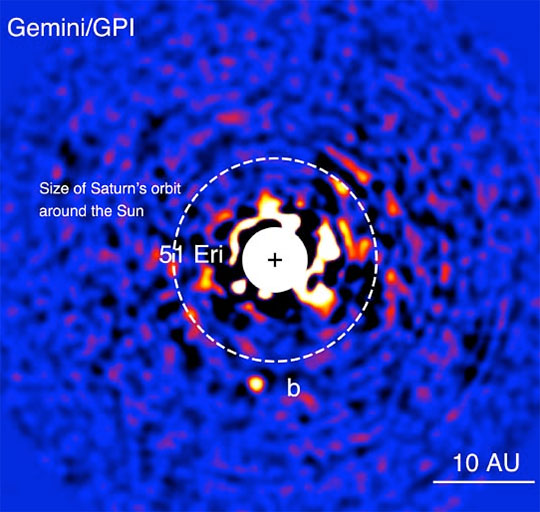
Figure 10. Discovery image of 51 Eridani b taken in the near-infrared light by the Gemini Planet Imager (GPI). The bright central star (51 Eri) has been mostly removed by a hardware and software mask to enable the detection of the
The researchers used planetary atmosphere and evolution models to estimate the properties of 51 Eridani b. Modeling the spectra and photometry yields the luminosity and an effective temperature of about 700 K. For this age and luminosity, “hot-start” formation models indicate a mass twice that of Jupiter. This planet also has a sufficiently low luminosity to be consistent with the “cold-start” core accretion process that may have formed Jupiter. The low temperature is supported by the presence of strong methane absorption that is not seen in other planets of similar age. Therefore, 51 Eri b provides an opportunity to study in detail a planet that is still influenced by its initial formation conditions. Its methane-dominated spectrum, low luminosity, and potentially low-entropy start, make 51 Eri b a bridge from the previously discovered wider-orbit, hotter, and more massive exoplanets to Jupiter-like scales. Investigating young solar systems will help astronomers understand the formation of our neighbor planets, and how common that planet-forming mechanism is throughout the universe.
Reference: “Discovery and Spectroscopy of the Young Jovian Planet 51 Eri b with the Gemini Planet Imager,” Sciencexpress, published online 13 August 2015; doi:
10.1126/science.aac5891. Bruce Macintosh (Kavli Institute at Stanford University) led the international research team, which included Didier Saumon (Materials and Physical Data, XCP-5), who performed theoretical modeling and data analysis for the project.
The research is based on observations obtained at the Gemini Observatory, which is operated by the Association of Universities for Research in Astronomy, Inc., under a cooperative agreement with the National Science Foundation on behalf of the Gemini partnership: the National Science Foundation (United States), the National Research Council (Canada), CONICYT (Chile), the Australian Research Council (Australia), Ministério da Ciência, Tecnologia e Inovação (Brazil) and Ministerio de Ciencia, Tecnología e Innovación Productiva (Argentina). NASA funded Didier Saumon’s research, which supports the Laboratory’s Nuclear and Particle Futures and Information, Science, and Technology science pillars. Technical contact: Didier Saumon






